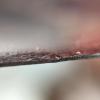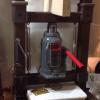-
Posts
276 -
Joined
-
Last visited
Content Type
Profiles
Forums
Events
Blogs
Gallery
Everything posted by Oldtoolsniper
-
Yes, I apologize for not specifying that. Wet/dry not the regular stuff. If you look up the work sharp 3000 you will see that entire system is designed around sandpaper. Google "Scary Sharp" it will answer a lot of questions on the sand paper method. You can get finer grits of wet dry on eBay and locally at any place that sells automotive finishes.
- 17 replies
-
- awl
- harness needles
-
(and 1 more)
Tagged with:
-
Learning to sharpen is 3/4's of the battle on sharpening. I own the tormek, work sharp,veritas, twice as sharp, Japanese Waterstones, ceramic stones, natural Arkansas stones, diamond stones, paper wheels, leather wheels, belt sanders and some other fancy things for making things sharp. I use sandpaper on glass or glued to MDF the most. It's like using a disposable razor compared to a straight razor. Hone your skills with sandpaper and get good quality equipment as your needs and skills improve. Learning how to sharpen will show you what you need to sharpen. Get a good set of magnified eyeballs so you can see the edge, as the picture I've included shows, I can't see that very good without magnification. The edge is magnified x21. I can clearly see that's not sharp and why. Sandpaper goes all the way to micro finish film. (Lee Valley tools) it will take you to hair splitting sharp with out learning how to maintain the sharpening tool itself.
- 17 replies
-
- awl
- harness needles
-
(and 1 more)
Tagged with:
-
So I could not figure out how to do a pattern that chief did on a belt. Arrowhead basket weave I believe he calls it. He did a video and now I can do it. Tandy stamp new from the store JLS is talking about. After watching the video and getting consistent results on scrap I started down my belt, I've driven nails, and spent many hours on the handle of an axe, sledgehammer, and or splitting maul so I'm pretty good at hitting the mark. I'm going down the belt and at around one third of the way down I started getting glancing blows, just one or two at first but they increased as I went. Now I'm the guy who just started to wear reading glasses and they focus at a certain point, that point was the tool meeting the leather not the maul meeting the stamp. Pretty soon I couldn't hit the mark at all, I was convinced I must have had some sort of mini stroke and lost my motor skills so off to the couch I went. When I got back to the bench I noticed that stamp, it was now curved. A 16 ounce maul bent that fine quality pot metal stamp into a nice c shape. I'm pretty sure it's some kind of pot metal since a magnet won't stick to it. They are cast not made from a blank like the old craftool co. tools are. I've learnt my lesson and now I buy the vintage stuff from eBay. As far as knifes go I have about twenty or so head knives. I'm a hoarder, I mean collector of tools to some extent. No you do not need one. Learn with a replaceable blade knife first, no use trying to learn how to sharpen a round knife until you are ready. It's a whole skill itself. Learn to strop that replaceable blade they are not very sharp even when new and you will have plenty of knife for most jobs.when I use one, I use one that the blade does not retract on, they are firmer meaning less blade flex, I also live alone so no worries about others getting cut with an exposed blade. Tandy does sell some tool shaped objects that you can learn with.
-

Shoulder Holster Critique
Oldtoolsniper replied to cleanview's topic in Gun Holsters, Rifle Slings and Knife Sheathes
I'm in search for one of those sewing manikins that is adjustable for that very thing. I find it hard to fit myself and design it while looking in the mirror. I use one as do most of the guys I know who run a trap line. Wading around in swamps and creeks all day with chest waders prohibits the use of a belt holster. The problem is that most of us use a .22 pistol and there are not a lot of .22 caliber sized shoulder holsters out there. Now finding a fat pot bellied manikin that will adjust down to a normal large sized guy too has been quite a challenge. I prefer the non boobed one too. -

When Do You Stop Cutting Yourself?
Oldtoolsniper replied to Chief31794's topic in Leatherwork Conversation
Wow does that bring back thoughts of a long recovery. I was whittling the end down on a ramrod for my muzzle loading shotgun. The knife I was using slipped from my hand and for some stupid reason I tried to catch it. The knife hit the bench on its rear and stopped point up, my hand stopped with the blade stuck all the way through my hand. Surgery took 4 1/2 hours, I have use of my hand but the last two fingers and palm are numb. That knife was really sharp, I'm pretty good at that, the surgeon was impressed he said if it wasn't so sharp the damage would have been harder to repair. The knife retails for around $11.00. It's the most expensive tool I now own. Surgery was just over $33,000.00. I got into leather work so I could make a sheath for every knife I own. I don't set a knife on the bench without putting the sheath on it. -
And I laced a can koozie and thought that was a lot of work! I Salute you sir!
-

Yet Another Few Questions On Vinegaroon
Oldtoolsniper replied to Windrider30's topic in How Do I Do That?
Some of the steel wool of lesser quality has some sort of oil or something on it to keep it from rusting. I rinsed mine in thinner just in case,I got some from horrible freight that was nicely coated with something that the vinegar could not cut through. It was next to impossible to get it to rust. Good quality steel wool is about a dollar more and not rust proof. Buy the oooo or extra fine or super fine and it will rust in days. -
Jim, Many thanks for answering that, and for posting all of the patterns you share with us.
-

Walnut And Maple Tool Rack Or Holder I Just Finished
Oldtoolsniper replied to Oldtoolsniper's topic in Leather Tools
Thanks for the compliments. -
That's sharp.
-
Made this out of 12 quarter walnut with Maple end caps. Holds a bunch of tools. I do wood working so the center part is branded with my obscenely large makers mark brand that was made by mistake for me. Lots of holes but I'm afraid I'm going to have to make another real soon. I'd love to see some others that folks have made. I may start making them to sell but none of them will be the same since I will be using up wood in the shop.
-
I use a wine cork on all my awls. Nice thing about the is I also use it on the back side of the leather to push the awl into as it goes through the the leather so it's not moving around while I stab it. My edge bevel tools all go in leather loops I formed out of a one inch strap. Just find a dowel or pvc pipe to make the loop part. The diameter needs to be the size that your handle can slide into but not fall through. If you want half inch spacing or three-quarter inch spacing or a 1 inch spacing between each tool simply buy a piece of molding that size and cut that into sections. Soak the strap. Tack the first spacer over the end of the strap. Put the first section of dowel/pvc pipe under the strap place the spacer next the the dowel and tack it on to give you the spacing you want, place the next dowel and them your spacer, tack, insert, repeat till the end. I tack mine to a two by for. I tack my spacers above and below the leather because nails will turn the leather black when wet. When it dries you have a tool bandolier you can attach to the wall. You need to use veg tan since chrome tan won't form.
-
He must have gotten fired from his 1 800 customer service job.
-

Holster Presses:
Oldtoolsniper replied to Pounder's topic in Gun Holsters, Rifle Slings and Knife Sheathes
Here was the dumb thing I did. It's 11 7/8" wide. I was not thinking about dimensions as much as the steel I had in the scrap pile. So you go down to the local steel boutique and guess what. A 12" chunk of steel in whatever thickness you want is there to buy pre cut. Yeah that 1/8" makes a big difference in making things simple. I know better too! I'm to lazy to make another one right yet but it would be faster than grinding that 1/8" off my plates. I also bought some corion (not sure on the spelling) trivets from the pots and pans section. It's the hard plastic countertop stuff. It's super smooth on one side so I can smoosh leather down nice and smooth after I case it. It's fun to play with, I even do my 1" critter stamps with it. Need a round cutter? Exhaust pipe comes in lots of round sizes as does electrical conduit. Twenty tons of pressure will make it cut. Need to laminate some exotic skin to a pice of leather prior to doing an inlay, this tool is your friend. Beware I have a chocolate lab hair producing machine. The hair will imprint the leather on those flat corion plates. -

Holster Presses:
Oldtoolsniper replied to Pounder's topic in Gun Holsters, Rifle Slings and Knife Sheathes
Here is a picture of my junkyard press. Above the two by four is the top tube welded solid, the bar below the two by four moves. I did this so I could get a feel for the amount of pressure I am applying. When I crushing the 2x4 I figure I've pretty much pressed into the leather whatever I'm pressing. The 2x4 is sort of a redneck safety valve, before I break a die the wood should crush. The springs attach to nuts welded on the uprights, the springs were 50 cents each at a garage sale. The square tube is 2" and fits inside a 2" trailer hitch socket. The socket that you weld on costs $9.99 for the tube at Fleet Farm. I sawed it in half that's why you see the big lip on one side, it's the flange on the back of the hitch receptacle. I used this because it was available local and it fits over the 2" square tube. That is the part directly above and below the jack that moves up and down. I did not know if it would work or not when I built it. Took about two hours to stick together and it was worth it. I keep thinking I'll sandblast it and paint it but then I just keep on using it so I never get around to making it pretty. I have access to welders so that part was simple. It's still not finish welded as it was only a test. My point it that it only has to work it does not need to be perfect and it is by no means a precision tool. I used a twenty ton jack because it was on clearance for $20.00. With the top bar under the 2x4 movable I can fit whatever size jack I want in there, just drill a hole and bolt the bar in place or in my case rip a 2x whatever down to the size of safety block I need. The jack is held in place by friction or spring pressure, it's not welded or mounted in place. I can take it out to jack up the pickup if need be. If you can make a rectangle or square frame you can make a press. -

Holster Presses:
Oldtoolsniper replied to Pounder's topic in Gun Holsters, Rifle Slings and Knife Sheathes
I have not pressed holsters with mine since I use a vacuum bag for veneering for that. For leather working a veneer vacuum press is even more limited, however in my case I already have it for veneer work. -

Holster Presses:
Oldtoolsniper replied to Pounder's topic in Gun Holsters, Rifle Slings and Knife Sheathes
I built mine all from scrap steel. Added a 20 ton jack and it's one of the most used tools I have. That press solves a lot of problems and I can emboss about any size stamp that's out there plus I can use it as a clicker. The taco is pretty limited in scope. -
I've made these for Kerr jars and I'm wondering why the leather is cut on curve rather than just a straight strip. Thanks
-
Art, Where do you get one of those?
-

Francis & Ward Round Or Head Knife Information Help.
Oldtoolsniper replied to Oldtoolsniper's topic in Leather Tools
Bruce , Many thanks on the information. I'm working on putting it back into leather working condition. I don't think this knife had an easy life. I will post pictures when she's back in working shape. -
Any chance there is a link to this tool as far as getting one?
-
Round knives are fun once you become comfortable with them and can get them freaky sharp. First thing I do is make a case for everyone I buy when it's ready to go back to work. I buy used ones and put them back in serviceable condition. The first thing it cuts is the leather for its new sheath. Just remember the the hand holding the leather NEVER EVER gets in the cutting path of that blade. Stop and rethink that cut if you feel compelled to put that other hand in front of that knife, dont do it even for a split second. My last knife mishap (not leather related) cost $33,000 for surgery, three permanently numb fingers, and three months of not being able to use my left hand. It happens in a split second of not thinking.





